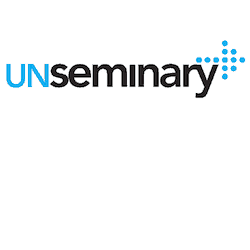
by unSeminary: Thanks for joining this week’s unSeminary podcast. This is multisite month and I’m excited to have Paul Martel with us today. He is the CEO and cofounder of Living As One.
Paul began his work doing broadcasts at Hewlett-Packard and managing their transmissions. In the meantime, he was also helping his church with A/V needs. When his church wanted to do video streaming at their campuses, Paul brought in the same technology from HP to make it happen. Whereas HP was using a private internet connection for their transmissions, however, the church had to use public internet connections. As a result, data transfer for the church was incredibly slow and the campus viewing experience was poor because video would cut out. Paul started Living As One in response to this problem churches have with streaming content to their locations.
Paul is with us today to talk about the technology that Living As One has created and how it can help with streaming video to church campuses.
The challenges of video delivery. // If you’re a church doing video teaching at your campuses, chances are you’re handling the transmission of that video in one of two ways. One method is to record your content to solid state hard drives and physically drive them to other campuses. However, this method can create a delay if the delivery isn’t on time, a file can get corrupted, or there can be on-the-spot errors that are difficult to solve in the moment. Another method churches use is to create a satellite connection in order to stream their content to campuses. But satellite is expensive at a $300,000 initial investment, plus additional costs for the satellite time as it’s used. Satellite also doesn’t work well for portable campuses because you have to set up a satellite receiver, and this can be tough for volunteers that don’t have the technical expertise.Another solution. // Paul and his team knew that they couldn’t fix the slow transfer rates of public internet connections and it would cost churches thousands and thousands of dollars for a private connection. So Living As One engineered another option for churches. They built their own hardware and software to capture the video and store everything at every step in the transmission process. This method put all of that data on local hard drives to make sure the broadcast was transmitted appropriately. Even if the internet at one location went out, everything was still stored and started back up where it left off when the connection returned.Simple and scaleable. // Because the system that Living As One developed is built through a cloud network, it’s incredibly scaleable. Plus it’s simple to use on both the broadcast sending and receiving end. The simplicity of the design eliminates the need for volunteers to have special expertise when it comes to using this system. The methods that Living As One uses make it easy to keep these broadcasts streaming on both ends and they teach users how to solve issues that may come up. Additionally, the system is set up to broadcast automatically during scheduled service times. If there are any problems, the system will send alerts directly to you.Easy setup for portable and small campuses. // Portable campuses are using this plan of streaming too since their internet is not always reliable. They can simply roll in their equipment on its rack during set-up and use wireless hot spots to broadcast the service. These systems have even been used in house churches where a group can gather to watch a message from another church. Some house churches in Australia that used this method grew so large that they became church campuses.
You can find out more about Living As One and how they can help your church at www.livingasone.com.
Thank You for Tuning In!
There are a lot of podcasts you could be tuning into today, but you chose unSeminary, and I’m grateful for that. If you enjoyed today’s show, please share it by using the social media buttons you see at the left hand side of this page. Also, kindly consider taking the 60-seconds it takes to leave an honest review and rating for the podcast on iTunes, they’re extremely helpful when it comes to the ranking of the show and you can bet that I read every single one of them personally!
Lastly, don’t forget to subscribe to the podcast on iTunes, to get automatic updates every time a new episode goes live!
Thank You to This Episode’s Sponsor: Red Letter Challenge
Red Letter Challenge is not only a plug-and-play campaign to help your church gain a better insight into the teaching of Jesus, but it will also help your church grow because of deeper engagement!
Source: Under the Hood of the Technology Driving So Many Multisite Churches with Paul Martel

